
table of contents
- Extend shelf life
- Cut flowers from the garden bed
- Chrysanthemums (Chrysanthemum)
- Dahlias (Dahlia)
- Gladiolus (gladiolus)
- Gerbera (Gerbera)
- Lilies (Lilium)
- Daffodils (Narcissus)
- Carnations (Dianthus)
- Flame flowers (phlox)
- Ranunculus (ranunculus)
- Delphinium
- Roses (pink)
- Sunflowers (Helianthus annuus)
- Tulips (tulipa)
- Companion plants
Many bulbous and bulbous plants, perennials and summer flowers are not only perfect for decorating beds, but also as cut flowers for the vase. Not all plants are suitable for a colorful, fragrant arrangement. You should definitely plant these flowers in the garden so that you always have a beautiful bouquet in the house.
Extend shelf life
Depending on the type and variety, cut flowers last between two days and two weeks in a vase. The shelf life also depends on the location and care. With cut flowers from your own garden, it is important to pay attention to the correct ripeness when cutting. For most flowers, it is optimal when the buds are just beginning to show color. Asters, chrysanthemums, carnations and sunflowers, on the other hand, should be almost in full bloom when they are cut. To keep bacterial growth in check, you should renew the water in the flower vase every two days and at the same time shorten the stem a little.
- Cutting time: early in the morning
- not in the midday heat
- Cut the peduncle diagonally with a sharp knife
- remove lower leaves
- ideal flower water: stale, lukewarm and low in lime
- Location: without direct sunlight or heating air
Tip: Most flowers are sensitive to drought. So that the interface does not dry out, it should be placed in a bucket of water immediately. A fill level of around 10 centimeters is sufficient so that the bucket is not too heavy during transport.
Cut flowers from the garden bed
With a little planning, you can pick a beautiful bouquet right in your own garden. Many types of flowers can take a cut and then bloom all the more profusely. So it's worth planting one of the following flowers.
Chrysanthemums (Chrysanthemum)
Only when the first winds blow in autumn do the colorful flower stars and pillow blossoms of the chrysanthemums come into their own in the garden. In almost every color on the palette, the beautiful flowers from the Far East shine in the beds and of course in the vase. Chrysanthemums are commercially available as cut flowers most of the year.
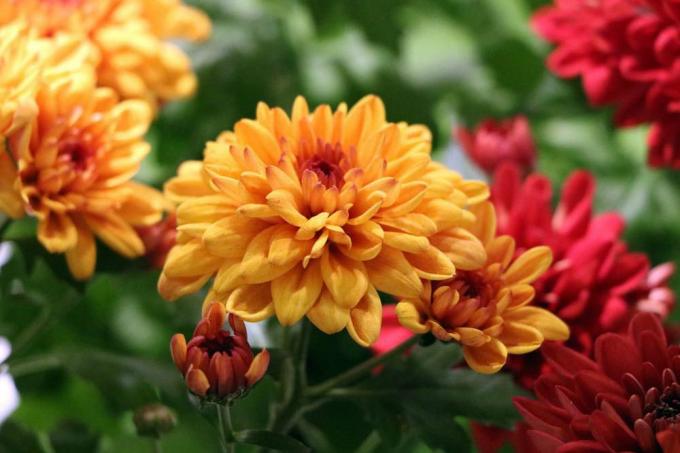
- Flowering period: from the end of September
- available in a variety of colors and shapes
- in the bouquet with: asters, lilies, gerberas, roses and ranunculus
Dahlias (Dahlia)
For a garden owner that is dahlia a very grateful cut flower. It is constantly producing new flowers, the more you cut it, the more it does. Cut the gorgeous pom-poms in a well-open state, but the center should still be closed. With all types of dahlias, make sure that the water supply is never interrupted after the cut, because this is the only way to keep the beautiful flowers fresh for a long time.
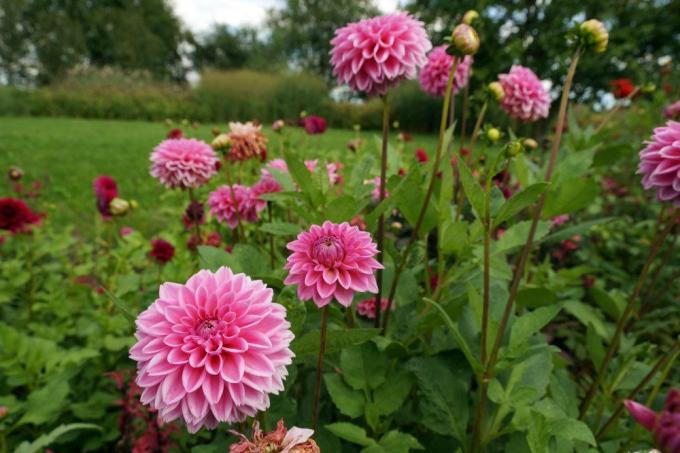
- Flowering period: July to October
- available in a variety of colors and shapes
- beautiful combinations: roses, chrysanthemums, ranunculus
Gladiolus (gladiolus)
The impressive flowers of the are certainly among the noble vase flowers gladiolus. With its long stems and large flowers, the sword flower is a highlight in the apartment in large floor vases. In order for the cut flower to last a long time, it is important not to cut the flower stem at an angle, but straight. As with all bulbous plants, you should avoid fresh flowers with gladioli and clean the vase daily.

- Flowering time: depending on the variety between June and September
- Color spectrum: white, pink, pink, yellow, orange, red and purple
- go well with: roses, bluebells, chrysanthemums, gerberas
Note: Never remove all of the flower stalks on a plant, otherwise the flower will die prematurely and no longer be able to store energy in the tuber.
Gerbera (Gerbera)
Not only as a pot plant, but also as a cut flower, the gerbera turns out to be a little diva. With the right care, the princess unfolds her beautiful summer colors among the flowers from her own garden, but also splendidly in the flower vase.

- Flowering time: persistent from May to September
- Color spectrum: predominantly orange and yellow tones
- also pink and pink flowers
- Combinations: anemones, inca lilies, roses, fresias
- Special features: daily cutting and water change
Lilies (Lilium)
the lily is one of the finest cut flowers ever. The great thing about the onion plants: They can also be kept for a long time in the vase. A few lily flowers with a little green are just as attractive as a colorful summer bouquet with other flowers. Since the pollen of lilies leaves unsightly yellow spots, the stamens can be carefully cut out when arranging them in a vase.

- Flowering period: depending on the variety, between May and August
- Color spectrum: white, pink, pink, red, yellow, orange and purple
- Compositions with: roses, chrysanthemums, gerberas
Daffodils (Narcissus)
Daffodils, also called daffodils, are the typical cut flowers at Easter time and are considered to be the herald of spring. Together with other flowers in the vase, they are unfortunately incompatible, as they secrete a poison that blocks the water absorption of other types of flowers. If you want to make a brightly colored bouquet, first put the daffodils in a separate flower vase for a day so that they can mucilage.

- Flowering period: March to April
- classic colors: yellow or white with a yellow center
- Color variations: soft pink, white petals with a colored center
- beautiful combinations: tulips, hyacinths, Spierstrauch
- Special features: only compatible with other flowers after pre-treatment
Carnations (Dianthus)
Carnations, also known as flowers of the gods, exude a bewitching scent and a sensual ambience. Above all Cloves are very easy to grow and last a long time in a bouquet. They are very easy to care for. You only need a gate when inserting it into the water.
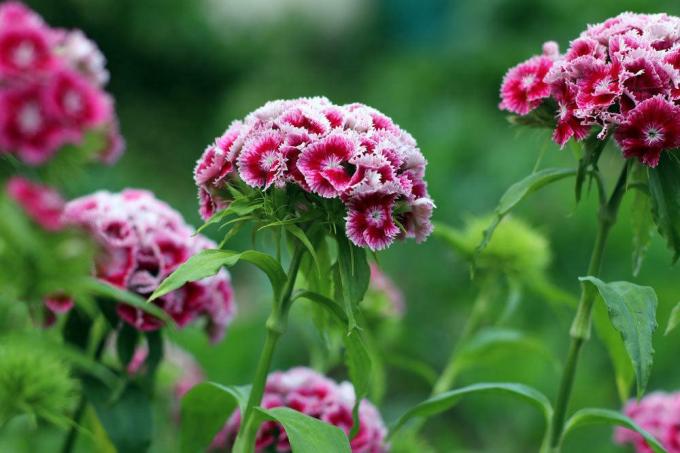
- Flowering time: depending on the variety from May to September
- Color spectrum: white and all pink to red tones
- colorful bouquets with: dahlias, cosmos
- Special features: do not set up near fruit
Flame flowers (phlox)
In a cottage garden or in the perennial bed, the phlox is an absolute must. Here the magnificent perennial makes its grand entrance in summer in an enormous variety of colors. Beauty can really show off in a colorful bouquet. The flame flower is not one of the most durable flowering plants in the vase, but you can enjoy at least its often fragrant flowers for about a week.
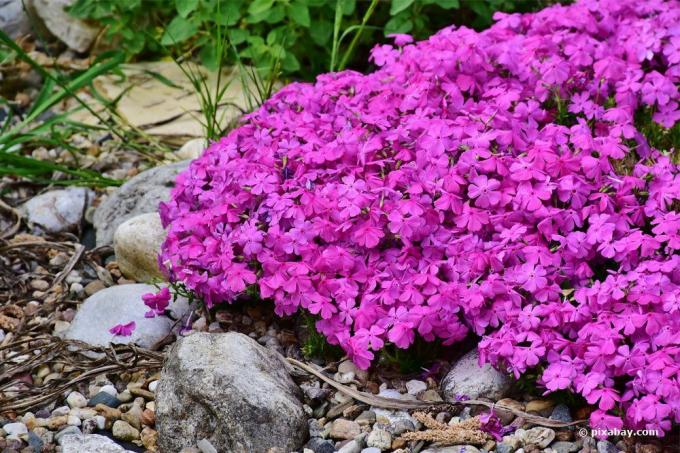
- Flowering time: depending on the variety between May and September
- Color spectrum: white, light pink, pink, violet, blue, red
- Combinations: dahlias, cosmos, delphinium, roses
- Special features: it is essential to use freshness-retaining agents
Ranunculus (ranunculus)
Ranunculus are perfect cut flowers that make every vase shine with their romantic double blooms. The longing for almost any color can be satisfied with the beautiful spring flowers. In Central Europe alone, over 100 different species of buttercup are known that grow in flower beds without much care.

- Flowering time: from the end of February to sometimes into summer
- Color spectrum: almost any color shade, even two-tone
- mixed bouquets with: roses, chrysanthemums, carnations, tulips
- Special features: freshly cut every two days, lukewarm water
Delphinium
The delphinium is undoubtedly one of the most impressive garden shrubs. The blue umbels, which, depending on the variety, can reach a height of over a meter, belong to the buttercup family (Ranunculaceae). Trim the long umbels when they are just showing color on the buds. The delphinium is attractive in a floor vase in combination with yellow and white partners. Then its blue flowers shine all the more.

- Flowering period: from June
- classic color: blue
- Color variations: white, yellow and pink varieties
- Combinations: roses, steppe candle, snapdragon, daisy
Roses (pink)
the rose is and remains the queen of flowers. Whether individually or as a bouquet, it is the epitome of love and romance. But it also gives grace and elegance to a colorful container. Roses that are available in stores are special cultivars with long, straight stems. Cut flowers from the home garden are in no way inferior to them and make every bouquet a highlight.
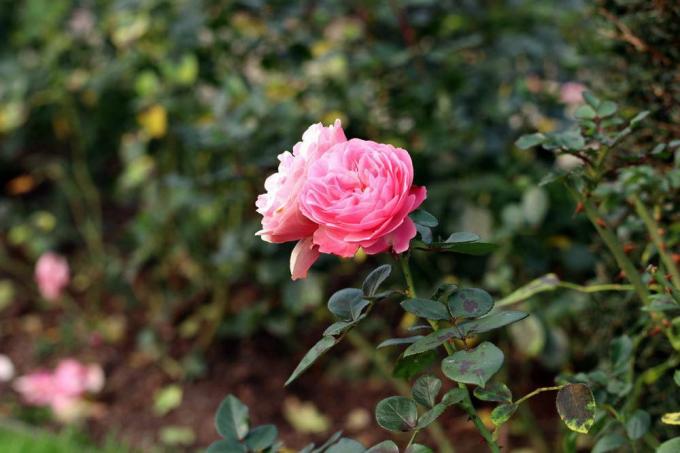
- Flowering period: from June
- classic colors: red, white, pink
- Color variations: yellow, apricot or orange and multi-colored varieties
- nice combinations: phlox, delphinium, Sea lavender, Chrysanthemum
Sunflowers (Helianthus annuus)
Sunflowers in a vase are a real eye-catcher in your home. In order for the bright yellow summer flower to last a long time, the half-open flower should be cut on a dry day if possible. Cut the stems two inches deep at the bottom and immerse them in boiling water for a few seconds. This procedure prevents the sunflower from rotting early.

- Flowering period: June to October
- Color spectrum: yellow, orange to red-brown
- together with: Gerbera, Rosen
- Special features: daily water change with lukewarm water
Tulips (tulipa)
Bring in a never ending variety of colors and flower shapes Tulips spring into the house. Nowadays there are over 4,000 varieties whose brightly colored flowers bring splashes of color into your home. Since tulips use a lot of water, it is best to place the harbingers of spring in a glass vase. So you can better control the water level.

- Flowering period: early April to May
- available in a variety of colors and shapes
- beautiful combinations: Christmas roses, lilies of the valley
- Special features: Do not exchange the water, just refill it
Companion plants
Particularly attractive bouquets for the vase can be created from different cut flowers that are color-coordinated. A few stalks of ornamental grasses loosen up the bouquet. All around, ornamental leaves such as hosta, lady's mantle or aralia leaves provide a suitable framework. If you would like to create something out of the ordinary, just add ornamental vegetables to a bouquet of flowers.



